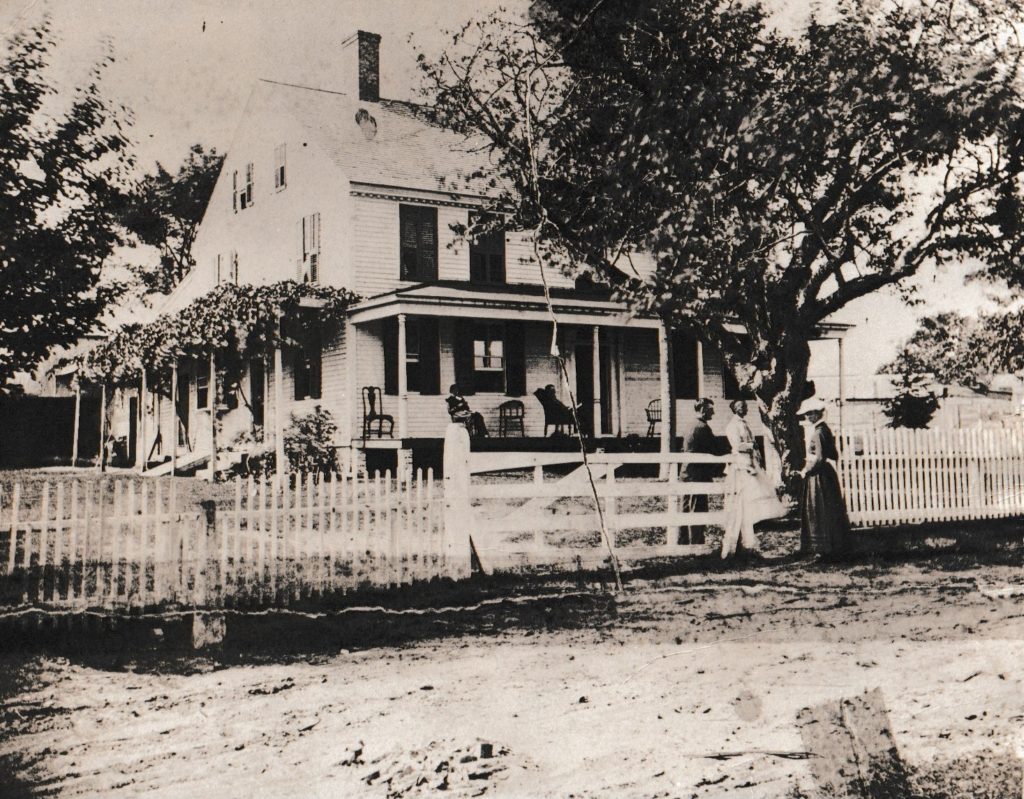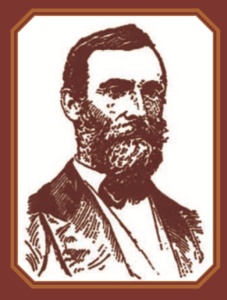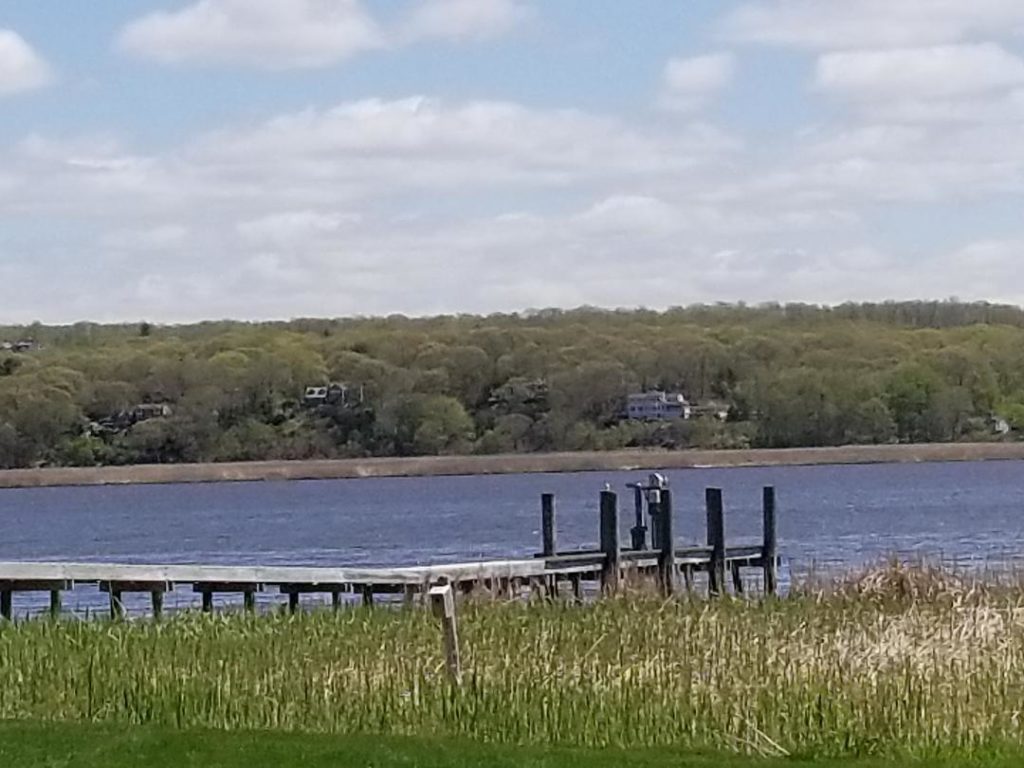By Teddy Levy
(c) Connecticut Explored Inc. Winter 2021-2022
Subscribe/Buy the Issue!
In 1896, when Edwin Ayer (1824 – 1901) was in his 70s and wishing his ancestors had written about their lives, he wrote of his life so that his descendants would not suffer the same disappointment. His story, spiced with more than routine activities, is now in the collection of the Old Saybrook Historical Society.
Ayer’s early years were spent in Saybrook (which became Old Saybrook in 1854) helping on the family farm on Ayer’s Point and fishing for shad in the Connecticut River. Before he was 24, he taught in the town’s district schools, had an unsuccessful venture shad fishing in Virginia and as a book salesman in the Midwest.
By the summer of 1848, though, rumors reached Connecticut that gold had been discovered in California. Ambitious, adventurous, confident, courageous, and determined, 24-year-old Ayer left his comfortable surroundings and set out to seek his fortune. Here, in his words, is how he remembered the adventure.
Along in the summer of ‘48 there began to be rumors of discoveries of gold in the newly acquired Territory of California. The rumors were received with various degrees of credulity, that country being so remote and so little being known of it and all modes of travel there so long and risky. More distant, difficult and dangerous than to any portion of the earth’s surface today, save only the two Polar regions of the earth. But at that time all business was suffering one of the greatest depressions that I can recall to mind. At that time there were thousands in all sections out of employment and wages at the lowest ebb. As a consequence, a great many people were giving thought and anxiety to the question of starting for the “Gold Region” as it was called and when men met it was apt to be the subject of discussion.
Like other men I had had the matter in consideration in my own mind when one evening several persons being at my father’s late in December and amongst them, cousin John Ayer, who surprise[d]me by saying, “Ed I will stump you to go.” Said I, “Do you mean it?” “I do.” “I shall take you up for sure.” And so we agreed to go to New Haven the next day, which we did, driving over in a sleigh, it being a very cold day.
We found the nucleus of a company forming with Lucius N. Finch and James Punderferd[?], two prominent business men as agents. We concluded to join and made arrangements to go over again soon and concluded the final formation of the company as a joint stock company under the organized name of “The New Haven and California Joint Stock Mining Co.” Seeming that John and myself were going to California, Mr. Henry Potter, after an interview with us, concluded to join with us in the enterprise. Arrangements were made to meet in New Haven on the 13th of February, expecting to sail the next day. Arriving at New Haven we found that the bark that we had bought in Philadelphia had not arrived. Potter returned to Saybrook to wait the arrival but John and I concluded to wait in New Haven. We waited about 3 days and then got a telegram from New York that the ship had met with an easterly snowstorm and had been forced to put in at Sandy Hook instead of coming in by Montauk Point as intended, the head of the Sound being obstructed by ice. They sent for a pilot and men to work the bark up to New Haven. Accordingly, John and I and the pilot went down on the Sound boat, the only boat that could beat through the heavy ice in the Sound.
We found at the Pier No. 4, East River, [New York] the bark Anna Reynolds. Captain and officers aboard, to-wit: John Bottom of Stonington, Master; first officer Alanson B. Webb of Orient [Long Island, New York]; second officer Joshua T. Nichols of Stonington. We wasted two days in New York, taking in stores, and then hired the big tug Sampson for $350 dollars to tow us up to New Haven. It took us from early morning till 10 o’clock at night to make the passage.
I was then put in charge of the ship … and took account of the cargo as it was delivered… . We had a house built on the deck which was as near to being the Black Hole of Calcutta as anything I ever knew of, for men to be forced to live in, and it gives me the horrors when I think of it. Its dimensions were 14’ by 20’ feet, with 18 double berths for 36 men to sleep in and live in. The rest stowed in the cabin, about 20, and 6 sailors in the forecastle. Other ships were about as badly overstowed. Still our crews lived to get there in the 255 days of our voyage. … The ship was stored solid full of stores of all kinds, calculated to last 2 years.
On the 12th of March, 1849, we were ready to sail. It had been blowing furiously from the N.W. for 5 days. On the morning of the 12th the wind still N.W. but not furious and I supposed we would sail by 8 or 9 o’clock, but in the crowd were many pious and timid Methodists and they got their city pastors, Dr. Floy and others and had to have prayers, singing and exhortations, which took till after eleven. Just as they were through with their devotions, the wind sprang up from the South and with the flood tide effectually suspended navigation out of the harbor.
In this contingency we hired one of the sound steamers to tow us out into the Sound for $150 dollars and we arrived at Stonington sometime in the night. We had to stop there to take on our water, boats and the Captain’s luggage, and then a hard easterly storm came on, so we were detained till the 17th, when we bade adieu to Yankeedom and were at sea very soon. The next day we took another easterly gale in the Gulf stream, which caused a casting up of accounts by a large majority, and being too crowded and wet and sick, made the dismal pumps prevalent.
We arrived at Port Augrande Island off St. Vincent Cape Debudis [probably São Vicente, Cape Verde]late in May with only the ordinary incidents of such a voyage. The place is a miserable settlement … but this harbor is considered the best in the Islands and there is an American Consulate there. We took in some supplies, wood and water, but the water was so impregnated with the fumes of sulphur. We left that (place) in about a week for Port Aruyce St. Jago [Cape Verde], which was then the station of the U.S. Africa Squadron, consisting of the flag ship Portsmouth, the Yorktown and the little brig Porpoise. This squadron was supposed to be engaged in the suppression of the African slave trade, but as all the ships were there lying at anchor and a full 300 miles from the African coast, it was not obvious how they could have been very effective. This place is a very fair place to obtain supplies, fruit of all kinds being plenty and of good quality. But, I could not see that the water which we took here was any improvement on that of the other place, in fact it was detestable. …
A “succession of gales of wind dead ahead” resulted in its taking the Anna Reynolds 42 days to reach the Falkland Islands in the middle of July.
These islands are strange and weird to suit any recluse. The area is near that of Connecticut but it is all rocky islands and lagoons more than a thousand in number, then there are terribly ugly reefs outside. They are all rocks, covered when at all by a soil of peat on which coarse grass grows and there are many wild cattle and horses, seals and sea lions and an animal—a kind of cross between a fox and a wolf. Sea birds without limit, we got near 700 geese and some of their wild beef and plenty of good water. Of fuel we could only get wreckage along the shores—no trees growing on the islands, only bunches of small bushes not larger than the finger.
There being many bad reefs of rocks a few miles from the islands it is quite difficult to get an offing in the short winter days and as snowsqualls are common and violent and the situation is frequently very dangerous, and such was our experience on our attempt to leave the island. We had light wind through the day and when night shut in we were inside of many reefs and a violent gale and snowstorm ahead set in and it seemed that shipwreck was inevitable. Instead of keeping our natural course down the east side of the islands we had to square away to the north and west of the islands and then when we got fairly around the N. West we took a southwest gale right on to the island. It was all that we could possibly do to haul off the lee shore, which we did by crowding on all sail to the extent of splitting our canvas. Luckily we had day light and by sunset we ran into a lagoon and a safe harbor.
This place is called East Falkland and is not inhabited. We stayed there near a week before the wind favored, when we left and on the second day we made [Staten Island], designing to sail through the Straits of LeMaire. Here we were headed off by gales and snow squalls and so had to go to the eastward of [Staten Island]. We had very stormy and cold passage around the Horn—head winds and much ice made on the ship and ran down to 60 [degrees]south, but when we had fairly doubled the Cape we had good weather and made the passage from East Falkland to Talcahuano [Chile] in 32 days.
Talcahuano is a fine seaport and had long been a great supply station for whale ships and the society of the place was just about what that fact would lead one to expect. It is a seaport of the City of Concepcion, 10 miles distant SE. It is a fine place to obtain supplies, excellent wheat, potatoes, and many varieties of fruit of excellent quality. It seemed to be a very fine country about there and I should think the climate as good as any upon the earth. The only drawback being the earthquakes, which are frequent and sometimes of appalling destructiveness.
While stopping there the Independence Day of [Chile] occurred there the 19th of Sept., if I remember rightly, and a party of us rode over to [Concepción] on horseback to spend the day just as Yankees do at home. I don’t think that I ever knew a Fourth of July at home spent with such zest. We stayed over night and had a royal time. Capt. Bottom of course, was on a lark all the time we were there. We did not mind that much while we were detained by business, but when we were ready to sail and he still detained us, we took the matter in hand and through the U.S. Consul discharged him with the condition that he could go with us but not as Master and Mate Webb was (then) installed as Captain.
After our detention of two weeks we sailed out of the port and took a fair S.S.E. wind, took our direct course just barely sighting Juan [Fernandez Islands]. We sailed 5,000 miles with studding sails set all the time, hardly having occasion to shift a sail or rope till we reached latitudes 14 degrees North, when we took the variable winds. Certainly a grander or pleasanter sail was never made on earth. Our speed was never less than 7 knots or more than 9 ½ —weather perfect, no rain or storm. We had variable winds and weather till within 3 days sail of the Golden Gate—then we met in collision (with) a large bark in the night.We struck head on and head on, she striking us just forward of the cat head, cutting our plank shear down below the deck and then cleared everything to our fore chains, the rigging of the bark fouled around the shank of our anchor and the fluke was crowded along to the fore chains and then held on and the two vessels swung together broadside to and rolling together in the sea way, crushed in our bulwarks near our whole lengths, their head rigging on our anchor holding the two ships together. On the other vessel they appeared dazed and did nothing toward clearing the foul rigging as we asked them to do. One of our men jumped aboard them with an ax and cut their rigging and the two ships swung clear with our man on board them.
Both ships hove to till morning, neither knowing how seriously they were damaged. The mate and myself took the gig next morning and went for the man left aboard them. Found the bark to be the Bark America of Hamburg, Germany. They said that from the number of men on us they suspected us to be pirates. Each vessel was about equally disabled—they more in their rigging and spars, and we in the hull. As luck would have it, the next day was fair and we repaired damage so as to meet a gale the day following.
The third day following the collision we made the dangerous [Farallon] Islands some 30 miles off the Golden Gate in a thick fog and nearly a gale of wind with a heavy sea following in and the steering of the ship was the most difficult I ever experienced. We came to anchor off the town at North Point and our long, perilous voyage was over.

Edwin Ayer on the porch (right), c. early 1890s, of the second Ayer home at Ayer’s Point, Old Saybrook. Edwin bought the house built by his grandfather John Ayer in 1852 and lived there until his death in 1901. Old Saybrook Historical Society
Ayer returned home October 20, 1852. After nearly two years in California, he “found all well, though some of the family questioned my identity … and thus ended the first lesson in Mining and Exploring.” Ayer brought home a modest fortune. He bought the family farm, married, and started a family. He served as state representative in 1872 and 1873, was town selectman, chairman of the school board, assessor, and justice of the peace, and for several years was president of the Saybrook Bank of Essex. Ayer died in March 1901 at home, leaving behind a fascinating tale of the life and adventures of a small-town Connectican.
Tedd Levy is a volunteer at the Old Saybrook Historical Society and frequent writer on history topics.
Explore!
Read Edwin Ayers’s full narrative at Saybrookhistory.org.
“John E. Brockett Goes for the Gold,” Winter 2016-2017
Memoir of North Haven’s John Brockett’s four years in the California Gold Fields.
“Round the Horn in Search of Seals and Fortune,” Summer 2013
New Haven’s Joel Root took a similar voyage in 1803 – 1806, including 17 months on Masafuera, one of the Juan Fernandez Islands.
GO TO NEXT STORY
GO BACK TO WINTER 2021-2022 CONTENTS



